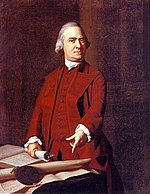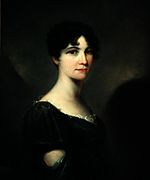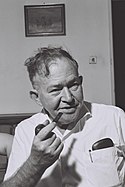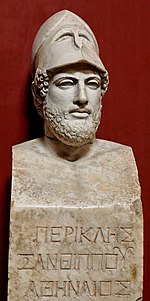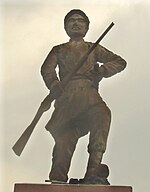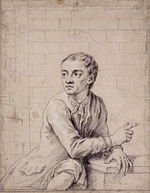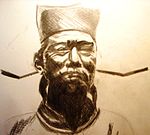Portal:History/Featured biography
| This Wikipedia page has been superseded by Portal:History and is retained primarily for historical reference. |
| Note: Article entries are now being transcluded directly on the main portal page. However, this page should be retained for historical reference. |
Process
[edit]This section uses a derivative of the layout template of the Selected article section of this portal, as the two sections are the same in form if different in content. If you wish to add a new selection to the article, use the following template:
{{Portal:History/Featured biography/Layout
|image=
|size=
|caption=
|text=
|link=
|biography=yes
}}
Added biographies should be Featured articles about prominent (or not so prominent) historical figures, and should be added to the first available slot, and then the max= parameter of this section's {{Random portal component}} template should be incremented. A current list of eligible articles can be found here; non-biographies should be nominated to the Selected article section instead. Try to avoid systematic bias; this section's selections were crafted to represent as wide a world view as possible. Lastly, if for some reason you wish to nominate a non-FA biography for inclusion, you can do so in the Nominations section at the bottom of this page.
Selections
[edit]Featured biography 1
Portal:History/Featured biography/1
Samuel Adams (September 27 [O.S. September 16] 1722 – October 2, 1803) was an American statesman, political philosopher, and one of the Founding Fathers of the United States. As a politician in colonial Massachusetts, Adams was a leader of the movement that became the American Revolution, and was one of the architects of the principles of American republicanism that shaped the political culture of the United States. He was a second cousin to President John Adams.Born in Boston, Adams was brought up in a religious and politically active family. A graduate of Harvard College, he was an unsuccessful businessman and tax collector before concentrating on politics. As an influential official of the Massachusetts House of Representatives and the Boston Town Meeting in the 1760s, Adams was a part of a movement opposed to the British Parliament's efforts to tax the British American colonies without their consent. His 1768 circular letter calling for colonial cooperation prompted the occupation of Boston by British soldiers, eventually resulting in the Boston Massacre of 1770. To help coordinate resistance to what he saw as the British government's attempts to violate the British Constitution at the expense of the colonies, in 1772 Adams and his colleagues devised a committee of correspondence system, which linked like-minded Patriots throughout the Thirteen Colonies. Continued resistance to British policy resulted in the 1773 Boston Tea Party and the coming of the American Revolution.
After Parliament passed the Coercive Acts in 1774, Adams attended the Continental Congress in Philadelphia, which was convened to coordinate a colonial response. He helped guide Congress towards issuing the Declaration of Independence in 1776, and helped draft the Articles of Confederation and the Massachusetts Constitution. Adams returned to Massachusetts after the American Revolution, where he served in the state senate and was eventually elected governor.
Featured biography 2
Portal:History/Featured biography/2
Alcibiades, son of Clinias, from the deme of Scambonidae (/ˌælsɪˈbaɪ.ədiːz/; Greek: Ἀλκιβιάδης Κλεινίου Σκαμβωνίδης, transliterated Alkibiádēs Kleiníou Skambōnidēs; c. 450–404 BC), was a prominent Athenian statesman, orator, and general. He was the last famous member of his mother's aristocratic family, the Alcmaeonidae, which fell from prominence after the Peloponnesian War. He played a major role in the second half of that conflict as a strategic advisor, military commander, and politician.During the course of the Peloponnesian War, Alcibiades changed his political allegiance on several occasions. In his native Athens in the early 410s BC, he advocated an aggressive foreign policy, and was a prominent proponent of the Sicilian Expedition, but fled to Sparta after his political enemies brought charges of sacrilege against him. In Sparta, he served as a strategic adviser, proposing or supervising several major campaigns against Athens. In Sparta too, however, Alcibiades soon made powerful enemies and was forced to defect to Persia. There he served as an adviser to the satrap Tissaphernes until his Athenian political allies brought about his recall. He then served as an Athenian General (Strategos) for several years, but his enemies eventually succeeded in exiling him a second time.
Featured biography 3
Portal:History/Featured biography/3
Harriet Arbuthnot (10 September 1793 – 2 August 1834) was an early 19th-century English diarist, social observer and political hostess on behalf of the Tory party. During the 1820s she was the "closest woman friend" of the hero of Waterloo and British Prime Minister, the 1st Duke of Wellington. She maintained a long correspondence and association with the Duke, all of which she recorded in her diaries, which are consequently extensively used in all authoritative biographies of the Duke of Wellington.Born into the periphery of the British aristocracy and married to a politician and member of the establishment, she was perfectly placed to meet all the key figures of the Regency and late Napoleonic eras. Recording meetings and conversations often verbatim, she has today become the "Mrs. Arbuthnot" quoted in many biographies and histories of the era. Her observations and memories of life within the British establishment are not confined to individuals but document politics, great events and daily life with an equal attention to detail, providing historians with a clear picture of the events described. Her diaries were themselves finally published in 1950 as The Journal of Mrs Arbuthnot.
Featured biography 4
Portal:History/Featured biography/4
Ramón Emeterio Betances y Alacán (April 8, 1827 – September 16, 1898) was a Puerto Rican nationalist. He was the primary instigator of the Grito de Lares revolution and is considered to be the father of the Puerto Rican independence movement. Since the Grito galvanized a burgeoning nationalist movement among Puerto Ricans, Betances is also considered "El Padre de la Patria" (Father of the Puerto Rican Nation). Because of his charitable deeds for people in need, he also became known as "The Father of the Poor."Betances was also a medical doctor and surgeon in Puerto Rico, and one of its first social hygienists. He had established a successful surgery and ophthalmology practice. Betances was also a diplomat, public health administrator, poet and novelist. He served as representative and contact for Cuba and the Dominican Republic in Paris.
An adherent of Freemasonry, his political and social activism was deeply influenced by the group's philosophical beliefs. His personal and professional relationships (as well as the organizational structure behind the Grito de Lares, an event that, in theory, clashes with traditional Freemason beliefs) were based upon his relationships with Freemasons, their hierarchical structure, rites and signs.
Featured biography 5
Portal:History/Featured biography/5
Edward Teach (c. 1680 – 22 November 1718), better known as Blackbeard, was a notorious English pirate who operated around the West Indies and the eastern coast of the American colonies. Although little is known about his early life, he was probably born in Bristol, England. He may have been a sailor on privateer ships during Queen Anne's War before settling on the Caribbean island of New Providence, a base for Captain Benjamin Hornigold, whose crew Teach joined sometime around 1716. Hornigold placed him in command of a sloop he had captured, and the two engaged in numerous acts of piracy. Their numbers were boosted by the addition to their fleet of two more ships, one of which was commanded by Stede Bonnet, but towards the end of 1717 Hornigold retired from piracy, taking two vessels with him.Teach captured a French merchant vessel, renamed it Queen Anne's Revenge, and equipped it with 40 guns. He became a renowned pirate, his cognomen derived from his thick black beard and fearsome appearance; he was reported to have tied lit fuses under his hat to frighten his enemies. He formed an alliance of pirates and blockaded the port of Charleston, South Carolina. After successfully ransoming its inhabitants, he ran Queen Anne's Revenge aground on a sandbar near Beaufort, North Carolina. He parted company with Bonnet, settling in Bath Town, where he accepted a royal pardon. But he was soon back at sea and attracted the attention of Alexander Spotswood, the Governor of Virginia. Spotswood arranged for a party of soldiers and sailors to try to capture the pirate, which they did on 22 November 1718. During a ferocious battle, Teach and several of his crew were killed by a small force of sailors led by Lieutenant Robert Maynard.
Featured biography 6
Portal:History/Featured biography/6
Daniel Boone (November 2, 1734 [O.S. October 22] – September 26, 1820) was an American pioneer, explorer, and frontiersman whose frontier exploits made him one of the first folk heroes of the United States. Boone is most famous for his exploration and settlement of what is now the Commonwealth of Kentucky, which was then beyond the western borders of the settled part of the Thirteen Colonies. This region legally belonged to both the Commonwealth of Virginia and to the American Indian Tribes at the time. Despite some resistance from American Indian tribes such as the Shawnee, in 1775 Boone blazed his Wilderness Road through the Cumberland Gap in the Appalachian Mountains from North Carolina and Tennessee into Kentucky. There he founded the village of Boonesborough, Kentucky, one of the first English-speaking settlements west of the Appalachians. Before the end of the 18th century, more than 200,000 European people migrated to Kentucky/Virginia by following the route marked by Boone.Boone was a militia officer during the Revolutionary War (1775–82), which in Kentucky was fought primarily between the European settlers and the British-aided Native Americans. Boone was captured by Shawnee warriors in 1778, who after a while adopted him into their tribe. Later, he left the Indians and returned to Boonesborough to help defend the European settlements in Kentucky/Virginia.
Boone was elected to the first of his three terms in the Virginia General Assembly during the Revolutionary War, and fought in the Battle of Blue Licks in 1782. Blue Lick was one of the last battles of the Revolutionary War, coming after Lord Cornwallis surrendered to Washington in October of 1781.
Featured biography 7
Portal:History/Featured biography/7
Joel Brand (April 25, 1906 – July 13, 1964) was a Hungarian sailor and odd-job man who became known for his role during the Holocaust in trying to save the Hungarian-Jewish community from deportation to the Auschwitz concentration camp. Described by historian Yehuda Bauer as a brave adventurer who felt at home in underground conspiracies and card-playing circles, Brand teamed up with fellow Zionists in Budapest to form the Aid and Rescue Committee, a group that helped Jewish refugees in Nazi-occupied Europe escape to the relative safety of Hungary, before the Germans invaded that country too in March 1944. Shortly after the invasion, Brand was asked by SS officer Adolf Eichmann to help broker a deal between the SS and the United States or Britain. Eichmann said he would release up to one million Hungarian Jews, if the Western Allies would supply Germany with 10,000 trucks and large quantities of soap, tea, and coffee.The negotiations, described by The Times as one of the most loathsome stories of the war, became known as the "blood for goods" proposal. Nothing came of it and historians can only guess whether Eichmann's offer was genuine. There are theories that it was a trick intended to persuade the Jewish community to board the trains to Auschwitz thinking they were being resettled, or that it was a cover for high-ranking SS officials to negotiate a peace deal with the U.S. and Britain that excluded the Soviet Union and perhaps even Adolf Hitler himself.
Featured biography 8
Portal:History/Featured biography/8
Pedro Álvares Cabral (Portuguese pronunciation: [ˈpeðɾu ˈaɫvɐɾɨʃ kɐˈβɾaɫ] in European Portuguese or Portuguese pronunciation: [ˈpedɾʊ ˈaʊ̯vaɾɪs kaˈbɾaʊ̯] in Brazilian Portuguese; c. 1467 or 1468 – c. 1520) was a Portuguese noble, military commander, navigator and explorer regarded as the discoverer of Brazil. Cabral conducted the first substantial exploration of the northeast coast of South America and claimed it for Portugal. While details of Cabral's early life are sketchy, it is known that he came from a minor noble family and received a good education. He was appointed to head an expedition to India in 1500, following Vasco da Gama's newly opened route around Africa. The object of the undertaking was to return with valuable spices and to establish trade relations in India—bypassing the monopoly on the spice trade then in the hands of Arab, Turkish and Italian merchants.Cabral was later passed over, possibly as a result of a quarrel with Manuel I, when a new fleet was assembled to establish a more robust presence in India. Having lost favour with the King, he retired to a private life of which few records survive. His accomplishments slipped mostly into obscurity for more than 300 years. Decades after Brazil's independence from Portugal in the 19th century, Cabral's reputation began to be reassessed by Emperor Pedro II of Brazil. Historians have long argued whether Cabral was Brazil's discoverer, and whether the discovery was accidental or intentional. The first question has been settled by the observation that the few, cursory encounters by explorers before him were barely noticed at the time and contributed nothing to the future development and history of the land which would become Brazil, the sole Portuguese-speaking nation in the Americas. On the second question, no definite consensus has been formed, and the intentional discovery hypothesis lacks solid proof. Nevertheless, although he was overshadowed by contemporary explorers, Cabral today is regarded as a major figure of the Age of Discovery.
Featured biography 9
Portal:History/Featured biography/9
Major-General Sir Isaac Brock KB (6 October 1769 – 13 October 1812) was a British Army officer and administrator. Brock was assigned to Canada in 1802. Despite facing desertions and near-mutinies, he commanded his regiment in Upper Canada (present-day Ontario) successfully for many years. He was promoted to major general, and became responsible for defending Upper Canada against the United States. While many in Canada and Britain believed war could be averted, Brock began to ready the army and militia for what was to come. When the War of 1812 broke out, the populace was prepared, and quick victories at Fort Mackinac and Detroit crippled American invasion efforts.Brock's actions, particularly his success at Detroit, earned him a knighthood, membership in the Order of the Bath, accolades and the sobriquet "The Hero of Upper Canada". His name is often linked with that of the Native American leader Tecumseh, although the two men collaborated in person only for a few days. Brock died at the Battle of Queenston Heights, which was nevertheless a British victory.
Featured biography 10
Portal:History/Featured biography/10
Count Nikita Moiseevich Zotov (Russian: Никита Моисеевич Зотов) (1644 – December 1717) was a childhood tutor and life-long friend of Russian Tsar Peter the Great (Russian: Пётр I Алексеевич, "Великий"). Historians disagree on the quality of Zotov's tutoring. Robert K. Massie, for example, praises his efforts, but Lindsey Hughes criticizes the education that he gave to the future Tsar.Not much is known about Zotov's life aside from his connection to Peter. Zotov left Moscow for a diplomatic mission to Crimea in 1680, and returned to Moscow before 1683. He became part of the "Jolly Company", a group of several dozen of Peter's friends that eventually formed The All-Jesting, All-Drunken Synod of Fools with Zotov being appointed "Prince-Pope" of the Synod, and regularly presiding over their entertainments and festivities. He accompanied Peter on many important occasions, such as the Azov campaigns and the extorturing information from the Streltsy on high treason after their uprising. Zotov held a number of state positions, including c.1701 a head position in the Tsar's personal secretariat (Russian: Тайная канцелярия). Three years before his death, Zotov married a woman 50 years his junior. He died in December 1717 of unknown cause.
Featured biography 11
Portal:History/Featured biography/11
Sir Raphael "Roy" Welensky, KCMG (20 January 1907 – 5 December 1991) was a Northern Rhodesian politician and the second and last prime minister of the Federation of Rhodesia and Nyasaland. Born in Salisbury, Southern Rhodesia (now Harare, Zimbabwe) to parents of Jewish and Afrikaner ancestry, he moved to Northern Rhodesia, became involved with the trade unions, and entered the colonial legislative council in 1938. There, he campaigned for the amalgamation of Northern and Southern Rhodesia (the latter under white self-government, the former under the colonial office). Although unsuccessful, he succeeded in the formation of the Federation of Rhodesia and Nyasaland, a state within the British Empire that sought to retain predominant power for the white minority while moving in a progressive political direction, in contrast to apartheid South Africa.Becoming Prime Minister of the Federation in 1957, Welensky opposed British moves towards native African rule, and used force to suppress politically motivated violence in the territories. After the advent of African rule in two of the Federation's three territories (Northern Rhodesia and Nyasaland, now Zambia and Malawi respectively), it collapsed in 1963. Welensky retired to Salisbury, where he re-entered politics and attempted to stop Rhodesia (formerly Southern Rhodesia) from unilaterally declaring itself independent. With the end of white rule in 1979, and the independence of Rhodesia as Zimbabwe under Robert Mugabe in 1980, Welensky moved to England, where he died in 1991.
Featured biography 12
Portal:History/Featured biography/12
Pericles (Greek: Περικλῆς, Periklēs, "surrounded by glory"; c. 495 – 429 BC) was a prominent and influential statesman, orator, and general of Athens during the city's Golden Age—specifically, the time between the Persian and Peloponnesian wars. He was descended, through his mother, from the powerful and historically influential Alcmaeonid family.Pericles had such a profound influence on Athenian society that Thucydides, his contemporary historian, acclaimed him as "the first citizen of Athens". Pericles turned the Delian League into an Athenian empire and led his countrymen during the first two years of the Peloponnesian War. The period during which he led Athens, roughly from 461 to 429 BC, is sometimes known as the "Age of Pericles", though the period thus denoted can include times as early as the Persian Wars, or as late as the next century.
Pericles promoted the arts and literature; this was a chief reason Athens holds the reputation of being the educational and cultural centre of the ancient Greek world. He started an ambitious project that generated most of the surviving structures on the Acropolis (including the Parthenon). This project beautified the city, exhibited its glory, and gave work to the people. Furthermore, Pericles fostered Athenian democracy to such an extent that critics call him a populist.
Featured biography 13
Portal:History/Featured biography/13
Phan Đình Phùng (1847 – January 21, 1896) was a Vietnamese revolutionary who led rebel armies against French colonial forces in Vietnam. He was the most prominent of the Confucian court scholars involved in anti-French military campaigns in the 19th century and was cited after his death by 20th-century nationalists as a national hero. He was renowned for his uncompromising will and principles—on one occasion, he refused to surrender even after the French had desecrated his ancestral tombs and had arrested and threatened to kill his family.Born into a family of mandarins from Hà Tĩnh Province, Phan continued his ancestors' traditions by placing first in the metropolitan imperial examinations in 1877. Phan quickly rose through the ranks under Emperor Tự Đức of the Nguyễn dynasty, gaining a reputation for his integrity and uncompromising stance against corruption. Phan was appointed as the Imperial Censor, a position that allowed him to criticise his fellow mandarins and even the emperor. As the head of the censorate, Phan's investigations led to the removal of many incompetent or corrupt mandarins.
Upon Tự Đức's death, Phan almost lost his life during a power struggle in the imperial court. The regent Tôn Thất Thuyết disregarded Tự Đức's will of succession, and three emperors were deposed and killed in just over a year. Phan protested against Thuyet's activities, was stripped of his honours and briefly jailed, before being exiled to his home province. At the time, France had just conquered Vietnam and made it a part of French Indochina. Along with Thuyết, Phan organised rebel armies as part of the Cần Vương movement, which sought to expel the French and install the boy Emperor Hàm Nghi at the head of an independent Vietnam. This campaign continued for three years until 1888, when the French captured Ham Nghi and exiled him to Algeria.
Featured biography 14
Portal:History/Featured biography/14
Witold Pilecki (May 13, 1901 – May 25, 1948; Polish pronunciation: [ˈvitɔlt piˈlɛt͡skʲi]; codenames Roman Jezierski, Tomasz Serafiński, Druh, Witold) was a soldier of the Second Polish Republic, the founder of the Secret Polish Army (Tajna Armia Polska) resistance group and a member of the Home Army (Armia Krajowa). As the author of Witold's Report, the first intelligence report on Auschwitz concentration camp, Pilecki enabled the Polish government-in-exile to convince the Allies that the Holocaust was taking place.During World War II, he volunteered for a Polish resistance operation to get imprisoned at Auschwitz in order to gather intelligence and escape. While in the camp, Pilecki organized a resistance movement and as early as 1941, informed the Western Allies of Nazi Germany's Auschwitz atrocities. He escaped from the camp in 1943 and took part in the Warsaw Uprising. He remained loyal to the London-based Polish government-in-exile and was executed in 1948 by the Stalinist secret police Urząd Bezpieczeństwa on charges of working for "foreign imperialism", thought to be a euphemism for MI6. Until 1989, information on his exploits and fate was suppressed by the Polish communist regime.
Featured biography 15
Portal:History/Featured biography/15 Wail Mohammed al-Shehri (Arabic: وائل الشهري, Wāīl ash-Shehrī; also transliterated as Alshehri) (July 31, 1973 – September 11, 2001) was one of five hijackers of American Airlines Flight 11, which was hijacked and flown into the North Tower of the World Trade Center as part of the September 11 attacks.
Shehri was an elementary school teacher from Khamis Mushait in the Asir region of Saudi Arabia. In early 2000 he traveled to Medina to seek treatment for mental problems. He and his younger brother Waleed traveled to Afghanistan in March 2000 and joined an Al-Qaeda training camp. The brothers were chosen, along with others from the same region of Saudi Arabia, to participate in the September 11 attacks. Once selected, Shehri returned to Saudi Arabia in October 2000 to obtain a clean passport, then returned to Afghanistan. In March 2001, he recorded his last will and testament on video.
Shehri arrived in the United States in early June 2001, staying in budget motels in the Boynton Beach area of south Florida. On September 5, 2001, Shehri traveled to Boston and checked into a motel with his brother. Six days later, Shehri arrived early in the morning at Boston's Logan International Airport and boarded American Airlines Flight 11. Fifteen minutes after take off, the flight was hijacked and deliberately crashed into the North Tower of the World Trade Center at 8:46 a.m.
Featured biography 16
Portal:History/Featured biography/16
Jack Sheppard (4 March 1702 – 16 November 1724) was a notorious English robber, burglar and thief of early 18th-century London. Born into a poor family, he was apprenticed as a carpenter but took to theft and burglary in 1723, with little more than a year of his training to complete. He was arrested and imprisoned five times in 1724 but escaped four times, making him a notorious public figure, and wildly popular with the poorer classes. Ultimately, he was caught, convicted, and hanged at Tyburn, ending his brief criminal career after less than two years. The inability of the notorious "Thief-Taker General" Jonathan Wild to control Sheppard, and injuries suffered by Wild at the hands of Sheppard's colleague, Joseph "Blueskin" Blake, led to Wild's downfall.Sheppard was as renowned for his attempts to escape imprisonment as he was for his crimes. An autobiographical "Narrative", thought to have been ghostwritten by Daniel Defoe, was sold at his execution, Jack Sheppard quickly followed by popular plays. The character of Macheath in John Gay's The Beggar's Opera (1728) was based on Sheppard, keeping him in the limelight for over 100 years. He returned to the public consciousness around 1840, when William Harrison Ainsworth wrote a novel entitled Jack Sheppard, with illustrations by George Cruikshank. The popularity of his tale, and the fear that others would be drawn to emulate his behaviour, led the authorities to refuse to license any plays in London with "Jack Sheppard" in the title for forty years.
Featured biography 17
Portal:History/Featured biography/17
John Linton Treloar, OBE (10 December 1894 – 28 January 1952) was an Australian archivist and the second director of the Australian War Memorial (AWM). During World War I he served in several staff roles and later headed the First Australian Imperial Force's (AIF) record-keeping unit. From 1920 Treloar played an important role in establishing the AWM as its director. He headed an Australian Government department during the first years of World War II, and spent the remainder of the war in charge of the Australian military's history section. Treloar returned to the AWM in 1946, and continued as its director until his death.Treloar's career was focussed on the Australian military and its history. Prior to World War I he worked as a clerk in the Department of Defence and, after volunteering for the AIF in 1914, formed part of the Australian Army officer Brudenell White's staff for most of the war's first years. He was appointed commander of the Australian War Records Section (AWRS) in 1917. In this position, he improved the AIF's records and collected a large number of artefacts for later display in Australia. Treloar was appointed the director of what eventually became the AWM in 1920, and was a key figure in establishing the Memorial and raising funds for its permanent building in Canberra. He left the AWM at the outbreak of World War II to lead the Australian Government's Department of Information, but was effectively sidelined for much of 1940. In early 1941 he was appointed to command the Australian military's Military History and Information Section with similar responsibilities to those he had held during World War I. He attempted to intervene in the management of the AWM during his absence, however, to the increasing frustration of its acting director. Treloar worked intensely in all his roles and suffered periods of ill-health as a result. Following the war, he returned to the Memorial in 1946 but his performance deteriorated over time, possibly due to exhaustion. He died in January 1952.
Featured biography 18
Portal:History/Featured biography/18
Jovan Vladimir or John Vladimir (Serbian Cyrillic: Јован Владимир; died 22 May 1016) was ruler of Duklja, the most powerful Serbian principality of the time, from around 1000 to 1016. He ruled during the protracted war between the Byzantine Empire and the First Bulgarian Empire. His close relationship with Byzantium did not save Duklja from the expansionist Tsar Samuel of Bulgaria, who conquered the principality in around 1010 and took Jovan Vladimir prisoner. A medieval chronicle asserts that Samuel's daughter, Theodora Kosara, fell in love with Vladimir and begged her father for his hand. The tsar allowed the marriage and returned Duklja to Vladimir, who ruled as his vassal.Vladimir was acknowledged as a pious, just, and peaceful ruler. He took no part in his father-in-law's war efforts. The warfare culminated with Samuel's defeat by the Byzantines in 1014; the tsar died soon afterward. In 1016 Vladimir fell victim to a plot by Ivan Vladislav, the last ruler of the First Bulgarian Empire. He was beheaded in front of a church in Prespa, the empire's capital, and was buried there. He was soon recognized as a martyr and saint; his feast day is celebrated on 22 May. His widow, Kosara, reburied him in the Prečista Krajinska Church, near his court in southeastern Duklja. In 1381 his remains were preserved in the Church of Saint Jovan Vladimir near Elbasan, and since 1995 they have been kept in the Orthodox cathedral of Tirana, Albania. The saint's remains are considered relics, and attract many believers, especially on his feast day, when the relics are taken to the church near Elbasan for a celebration.
Featured biography 19
Portal:History/Featured biography/19
Shen Kuo (Chinese: 沈括; pinyin: Shěn Kuò; Wade–Giles: Shen K'uo) (1031–1095), style name Cunzhong (存中) and pseudonym Mengqi (now usually given as Mengxi) Weng (夢溪翁), was a polymathic Chinese scientist and statesman of the Song Dynasty (960–1279). Excelling in many fields of study and statecraft, he was a mathematician, astronomer, meteorologist, geologist, zoologist, botanist, pharmacologist, agronomist, archaeologist, ethnographer, cartographer, encyclopedist, general, diplomat, hydraulic engineer, inventor, academy chancellor, finance minister, governmental state inspector, poet, and musician. He was the head official for the Bureau of Astronomy in the Song court, as well as an Assistant Minister of Imperial Hospitality. At court his political allegiance was to the Reformist faction known as the New Policies Group, headed by Chancellor Wang Anshi (1021–1086).In his Dream Pool Essays (夢溪筆談; Mengxi Bitan) of 1088, Shen was the first to describe the magnetic needle compass, which would be used for navigation (first described in Europe by Alexander Neckam in 1187). Shen discovered the concept of true north in terms of magnetic declination towards the north pole, with experimentation of suspended magnetic needles and "the improved meridian determined by Shen's [astronomical] measurement of the distance between the pole star and true north". This was the decisive step in human history to make compasses more useful for navigation, and may have been a concept unknown in Europe for another four hundred years (evidence of German sundials made circa 1450 show markings similar to Chinese geomancer compasses in regards to declination).
Featured biography 20
Portal:History/Featured biography/20
Suleiman I (/ˈsuːlimɑːn/; Ottoman Turkish: سلطان سليمان اول, Sultān Suleimān-i evvel or قانونى سلطان سليمان, Kānūnī Sultān Suleimān, Modern Turkish: I. Süleyman (Turkish pronunciation: [sylejman]) or Kanuni Sultan Süleyman; 6 November 1494 – 5/6/7 September 1566) was the tenth and longest-reigning Sultan of the Ottoman Empire, from 1520 to his death in 1566. He is known in the West as Suleiman the Magnificent and in the East, as "The Lawgiver" (Turkish: Kanuni; Arabic: القانونى, al‐Qānūnī), for his complete reconstruction of the Ottoman legal system. Suleiman became a prominent monarch of 16th-century Europe, presiding over the apex of the Ottoman Empire's military, political and economic power. Suleiman personally led Ottoman armies to conquer the Christian strongholds of Belgrade, Rhodes, and most of Hungary before his conquests were checked at the Siege of Vienna in 1529. He annexed most of the Middle East in his conflict with the Safavids and large swathes of North Africa as far west as Algeria. Under his rule, the Ottoman fleet dominated the seas from the Mediterranean to the Red Sea and the Persian Gulf.At the helm of an expanding empire, Suleiman personally instituted legislative changes relating to society, education, taxation, and criminal law. His canonical law (or the Kanuns) fixed the form of the empire for centuries after his death. Not only was Suleiman a distinguished poet and goldsmith in his own right; he also became a great patron of culture, overseeing the golden age of the Ottoman Empire's artistic, literary and architectural development. He spoke four languages: Ottoman Turkish, Arabic, Chagatai (a dialect of Turkic languages and related to Uyghur), and Persian.
Featured biography 21
Portal:History/Featured biography/21
Joan of Arc (French: Jeanne d'Arc [ʒan daʁk]; Middle French: Jehanne Darc [ʒəˈãnə ˈdark]; c. 1412 – 30 May 1431) is a patron saint of France, honored as a defender of the French nation for her role in the siege of Orléans and her insistence on the coronation of Charles VII of France during the Hundred Years' War. Claiming to be acting under divine guidance, she became a military leader who transcended gender roles and gained recognition as a savior of France.Joan was born to a propertied peasant family at Domrémy in northeast France. In 1428, she requested to be taken to Charles VII, later testifying that she was guided by visions from the archangel Michael, Saint Margaret, and Saint Catherine to help him save France from English domination. Convinced of her devotion and purity, Charles sent Joan, who was about seventeen years old, to the siege of Orléans as part of a relief army. She arrived at the city in April 1429, wielding her banner and bringing hope to the demoralized French army. Nine days after her arrival, the English abandoned the siege. Joan encouraged the French to aggressively pursue the English during the Loire Campaign, which culminated in another decisive victory at Patay, opening the way for the French army to advance on Reims unopposed, where Charles was crowned as the King of France with Joan at his side. These victories boosted French morale, paving the way for their final triumph in the Hundred Years' War several decades later. (Full article...)
Featured biography 22
Portal:History/Featured biography/22
Malcolm X (born Malcolm Little, later el-Hajj Malik el-Shabazz; May 19, 1925 – February 21, 1965) was an African American revolutionary, Muslim minister and human rights activist who was a prominent figure during the civil rights movement until his assassination in 1965. A spokesman for the Nation of Islam (NOI) until 1964, he was a vocal advocate for Black empowerment and the promotion of Islam within the African American community. A controversial figure accused of preaching violence, Malcolm X is also a widely celebrated figure within African American and Muslim communities for his pursuit of racial justice.Malcolm spent his adolescence living in a series of foster homes or with relatives after his father's death and his mother's hospitalization. He committed various crimes, being sentenced to 8 to 10 years in prison in 1946 for larceny and burglary. In prison, he joined the Nation of Islam, adopting the name Malcolm X to symbolize his unknown African ancestral surname while discarding "the white slavemaster name of 'Little'", and after his parole in 1952, he quickly became one of the organization's most influential leaders. He was the public face of the organization for 12 years, advocating Black empowerment and separation of Black and White Americans, and criticizing Martin Luther King Jr. and the mainstream civil rights movement for its emphasis on non-violence and racial integration. Malcolm X also expressed pride in some of the Nation's social welfare achievements, such as its free drug rehabilitation program. From the 1950s onward, Malcolm X was subjected to surveillance by the Federal Bureau of Investigation (FBI).
In the 1960s, Malcolm X began to grow disillusioned with the Nation of Islam, as well as with its leader, Elijah Muhammad. He subsequently embraced Sunni Islam and the civil rights movement after completing the Hajj to Mecca and became known as "el-Hajj Malik el-Shabazz", which roughly translates to "The Pilgrim Malcolm the Patriarch". After a brief period of travel across Africa, he publicly renounced the Nation of Islam and founded the Islamic Muslim Mosque, Inc. (MMI) and the Pan-African Organization of Afro-American Unity (OAAU). Throughout 1964, his conflict with the Nation of Islam intensified, and he was repeatedly sent death threats. On February 21, 1965, he was assassinated in New York City. Three Nation members were charged with the murder and given indeterminate life sentences. In 2021, two of the convictions were vacated. Speculation about the assassination and whether it was conceived or aided by leading or additional members of the Nation, or with law enforcement agencies, has persisted for decades.
He was posthumously honored with Malcolm X Day, on which he is commemorated in various cities across the United States. Hundreds of streets and schools in the U.S. have been renamed in his honor, while the Audubon Ballroom, the site of his assassination, was partly redeveloped in 2005 to accommodate the Malcolm X and Dr. Betty Shabazz Memorial and Educational Center. A posthumous autobiography, on which he collaborated with Alex Haley, was published in 1965. (Full article...)
Featured biography 23
Portal:History/Featured biography/23
George Wilcken Romney (July 8, 1907 – July 26, 1995) was an American businessman and Republican Party politician. He was chairman and president of American Motors Corporation from 1954 to 1962, the 43rd Governor of Michigan from 1963 to 1969, and the United States Secretary of Housing and Urban Development from 1969 to 1973. He was the father of former Governor of Massachusetts and 2012 Republican presidential nominee Mitt Romney and the husband of former Michigan U.S. Senate candidate Lenore Romney. Romney was born to American parents living in the Mormon colonies in Mexico; events during the Mexican Revolution forced his family to flee back to the United States when he was a child. The family lived in several states and ended up in Salt Lake City, Utah, where they struggled during the Great Depression. Romney worked in a number of jobs, served as a Mormon missionary in the United Kingdom, and attended several colleges in the U.S. but did not graduate from any. In 1939 he moved to Detroit and joined the American Automobile Manufacturers Association, where he served as the chief spokesman for the automobile industry during World War II and headed a cooperative arrangement in which companies could share production improvements. He joined Nash-Kelvinator in 1948, and became the chief executive of its successor, American Motors Corporation, in 1954. There he turned around the struggling firm by focusing all efforts on the compact Rambler car. Romney mocked the products of the "Big Three" automakers as "gas-guzzling dinosaurs" and became one of the first high-profile, media-savvy business executives. Devoutly religious, he presided over the Detroit Stake of The Church of Jesus Christ of Latter-day Saints.
Nominations
[edit]I nominate Joseph Smith as a featured biography.217.230.253.110 (talk) 17:27, 31 December 2011 (UTC)
- I'm going to have to say no, because, as you'll notice all of the articles in this section are Featured articles, and Smith has failed a FAC and two GACs, in the recent past; it does not meet our quality standards, sorry. ResMar 19:57, 31 December 2011 (UTC)

